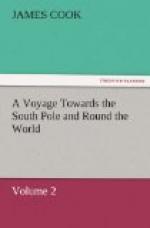same height; so that the whole is like a long square
trough, about three feet shorter than the body of
the canoe; that is, a foot and a half at each end.
Two canoes, thus fitted, are secured to each other,
about three feet asunder, by means of cross spars,
which project about a foot over each side. Over
these spars is laid a deck, or very heavy platform,
made of plank, and small round spars, on which they
have a fire-hearth, and generally a fire burning;
and they carry a pot or jar to dress their victuals
in. The space between the two canoes is laid with
plank, and the rest with spars. On one side of
the deck, and close to the edge, is fixed a row of
knees, pretty near to each other, the use of which
is to keep the masts, yards, etc. from, rolling
over-board. They are navigated by one or two
lateen-sails, extended to a small lateen-yard, the
end of which fixes in a notch or hole in the deck.
The foot of the sail is extended to a small boom.
The sail is composed of pieces of matting, the ropes
are made of the coarse filaments of the plantain-tree,
twisted into cords of the thickness of a finger; and
three or four more such cords, marled together, serve
them for shrouds, etc. I thought they sailed
very well; but they are not at all calculated for
rowing or paddling. Their method of proceeding,
when they cannot sail, is by sculling, and for this
purpose there are holes in the boarded deck or platform.
Through these they put the sculls, which are of such
a length, that, when the blade is in the water, the
loom or handle is four or five feet above the deck.
The man who works it stands behind, and with both
his hands sculls the vessel forward. This method
of proceeding is very slow; and for this reason, the
canoes are but ill calculated for fishing, especially
for striking of turtle, which, I think, can hardly
ever be done in them. Their fishing implements,
such as I have seen, are turtle-nets, made, I believe,
of the filaments of the plantain-tree twisted; and
small hand-nets, with very minute meshes made of fine
twine and fish-gigs. Their general method of
fishing, I guess, is to lie on the reefs in shoal
water, and to strike the fish that may come in their
way. They may, however, have other methods, which
we had no opportunity to see, as no boat went out
while we were here; all their time and attention being
taken up with us. Their canoes are about thirty
feet long, and the deck or platform about twenty-four
in length, and ten in breadth. We had not, at
this time, seen any timber in the country so large
as that of which their canoes were made. It was
observed that the holes, made in the several parts,
in order to sew them together, were burnt through,
but with what instrument we never learnt. Most
probably it was of stone, which may be the reason why
they were so fond of large spikes, seeing at once
they would answer this purpose. I was convinced
they were not wholly designed for edge-tools, because
every one shewed a desire for the iron belaying-pins
which were fixed in the quarter-deck rail, and seemed
to value them far more than a spike-nail, although
it might be twice as big. These pins, which are
round, perhaps have the very shape of the tool they
wanted to make of the nails. I did not find that
a hatchet was quite so valuable as a large spike.
Small nails were of little or no value; and beads,
looking-glasses, etc. they did not admire.




